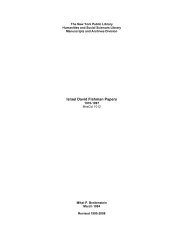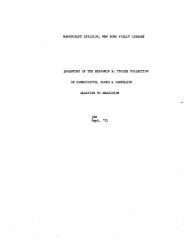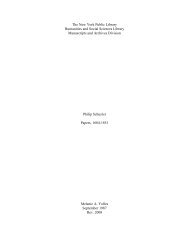pdf available - Multiple Choices
pdf available - Multiple Choices
pdf available - Multiple Choices
Create successful ePaper yourself
Turn your PDF publications into a flip-book with our unique Google optimized e-Paper software.
answer is more complicated than for any other<br />
rabbi in Luboml.<br />
According to encyclopedias and rabbinical<br />
anthologies, R. Shimon-Wolf was the fourth rabbi<br />
in Luboml, following R. Moyshe Mess. We would<br />
use the same order, except that according to our<br />
calculations it has no basis, as it conflicts with<br />
other facts and data. Why?<br />
It is clear from all <strong>available</strong> sources, among<br />
them his tombstone, that the first three rabbinical<br />
posts of R Shimon-Wolf were Turbin, Luboml,<br />
and Lublin. The time he spent in the first two<br />
communities is unknown to us, but we do know<br />
that he was head of the rabbinical court (and head<br />
of the yeshiva?) in Lublin from 1579 until 1585.<br />
By all accounts, since R Shimon-Wolf was<br />
head of the rabbinical court in Luboml before he<br />
went to Lublin , his tenure in Luboml must have<br />
been prior to 1579. But if we assume the accuracy<br />
of all encyclopedias and rabbinical genealogies,<br />
it appears that R. Shimon-Wolf was rabbi in<br />
Luboml after R. Moyshe Mess.<br />
But we are certain (from one of his own<br />
books) that R. Moyshe Mess was rabbi in Luboml<br />
from 1596 to 1597, thus R. Shimon-Wolf would<br />
have been head of the rabbinical court at the end<br />
of the 1590s, a full 20 years after he came to<br />
Lublin. But this is impossible for another reason:<br />
The rabbinate in Luboml at that time was occupied.<br />
In short, the issue is very confused, and it<br />
seems to us that R. Shimon-Wolf was not rabbi in<br />
Luboml after R. Moyshe Mess but after R. Avrom<br />
Pollackand he was there only for a very short<br />
time.<br />
The rabbi and sage R. Shimon-Wolf, son of<br />
Dovid Tevli Auerbach, was one of the most esteemed<br />
rabbis of his time, as can be seen from all<br />
the important posts he later held. In one place he<br />
is referred to as nothing less than "one of the seven<br />
pillars of the world, a light to the Exile"and this<br />
was no exaggeration, as sometimes happens when<br />
rabbinic titles are given, for among the other seven<br />
pillars we find such geniuses and Torah luminarles<br />
as the Maharshe," the Bach, and the author of<br />
°Belot Ephraim, R. Shloyme Ephraim Lunshitz."<br />
Before coming to Luboml, R. Shimon-Wolf<br />
was head of the rabbinical court in Turbin, but<br />
there, too, he remained only a short while.<br />
THE EARLY DAYS 25<br />
That R. Shimon-Wolf was one of the greats of<br />
his time can be deduced from the fact that he ran<br />
a great yeshiva in Lublin at the same time as the<br />
Maharam, who already was considered one of the<br />
greatest gaonim; he was at the same time a rosh<br />
metivta in another yeshiva, while serving as av<br />
bet din [head of the rabbinical court] in the town.<br />
In all the talk of the Maharam being the<br />
competitor of R. Shimon-Wolf, there is no little<br />
exaggeration. True, the Maharam was not one of<br />
the easiest to be around and did not particularly<br />
suffer from modesty. He thought highly of his<br />
own genius and had sharp words even for the<br />
greatest scholars of his day and of previous eras.<br />
There are biting comments in his books directed<br />
at scholars such as the Bet Yosef, the Ramah, the<br />
Maharsha, Rashal baal HaLevushim, and the<br />
Samah. For example, in his responsa (sec. 194)<br />
the Maharam of Lublin says about the Bet Yosef,<br />
"I have not only caught him on this viewpoint,<br />
but I have stacks and stacks of opinions contrary<br />
to his and to the erroneous words he has said."<br />
But in the beginning the Maharam did get<br />
along with R. Shimon-Wolf. They even coordinated<br />
the studies in the yeshivas so that they were<br />
both teaching the same tractate. The two sages<br />
had apparently agreed that on the basis of their<br />
simultaneous innovations a grand intellectual<br />
talmudic structure would later be built, the details<br />
of which are not known.<br />
But this idyll did not last. The disputea<br />
dispute for the sake of Heavenbroke out precisely<br />
because of their simultaneous new interpretations<br />
of the same talmudic tractate.<br />
We learn of this from the well-known<br />
Serotzker Ray, R. Yosef Levinshteyn, who was<br />
related, through his father and mother, to both the<br />
Maharam and R. Shimon-Wolf."<br />
After every session, especially when it was a<br />
difficult one and each rosh yeshiva had to resolve<br />
difficult issues, students from both yeshivas later<br />
asked one another, "How did your rabbi decide<br />
the issue?" When the answer was not identical,<br />
the students began to quarrel, each saying their<br />
rabbi had given the correct answer.<br />
The quarrels among students obviously had<br />
to reach their rabbis. When the communal leaders<br />
saw that a simple compromise could not<br />
prevent the conflict from continually flaring up







